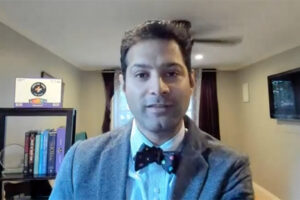
Burnout is not an occasional personal problem. Burnout burdens the entire health care universe.
Providers with even mild symptoms of burnout have a nearly three-fold increased risk for clinical depression, while those with severe symptoms have a 92.75-fold risk. Patients cared for by burned out providers have suboptimal outcomes, and burned out providers are up to three times more likely to switch jobs or leave medicine compared to their colleagues.
“At the organizational level, burnout costs $7,600 per physician per year in terms of replacement costs,” said Gretchen Winter, MD, Assistant Professor of Medicine, University of Alabama at Birmingham. “At the national level, burnout costs $4.6 billion every year. A burned out provider increases stress and burnout for other members of the team.”
Dr. Winter opened an exploration of The New Wave of Burnout: Impact and Interventions on Sunday. It isn’t the first time CHEST has addressed burnout, first studied in clinical settings in 1974.

“Burnout even has its own ICD-10 code, Z73.0,” said Saadia A. Faiz, MD, FCCP, Professor of Pulmonary Medicine, The University of Texas MD Anderson Cancer center. “Burnout needs to be addressed not just at the personal level, but at the organizational and national levels as well. Efficiency demands, resource allocations, reimbursement, bureaucratic burdens, and other stressors that contribute to burnout come from the outside.”
Because of the stress on the health care system, COVID-19 deeply exacerbated the issue of burnout.
“We were burned out before the pandemic,” said Lakshmana Swamy, MD, MBA, Instructor in Medicine at Harvard Medical school and Associate Professor, University of Massachusetts Medical School. “A third of ICU nurses admitted to burnout, 45% of physicians, and 71% of PICU providers.”
Nearly 2 years into COVID, burnout remains a syndrome characterized by emotional exhaustion, depersonalization, and feelings of low personal accomplishment, Dr. Winter noted. Pandemic-era studies underline links between treating patients with COVID-19, burnout, growing mental health burdens, and increasing numbers of providers leaving health care.

“Burnout is an occupational problem, not a personal issue,” said Rachel Quaney, MD, Pulmonary and Critical Care Fellow, The Ohio State University Wexner Medical Center. “The best cure for burnout is prevention.”
Multiple models of burnout all focus on five consistent drivers across different sizes and types of organizations: workload, control, community, values, and rewards.
“Every institution and workplace is different, but these core aspects are seen repeatedly as occupational drivers of burnout,” Dr. Quaney said. “The most obvious problem driving burnout is having too much to do with too little time and too few resources to accomplish the job.”
Burnout is global, but mitigation is local. Instead of trying to reduce burnout across an entire hospital, it is more useful to work with a smaller defined group such as ICU nurses or physicians, or respiratory therapists.
The next step is to assess the specific drivers of burnout in that particular group, from excess hours to lack of input in scheduling, then launch multimodal interventions. And start the cycle again.

“This is an iterative process that goes on and on,” Dr. Quaney said. “The time is now to address burnout.”
Taking care of yourself is the toughest assignment of all during a pandemic, Dr. Swamy added.
“Sleep is critical,” he said. “You cannot function without enough sleep. Your mood suffers, your performance suffers. There is a huge emotional component. Every one of us has to deal with death every day. I take care of a lot of people, and I don’t know if I made a difference. Our sense of purpose is in danger.”
Simply doing something positive outside the ICU and outside medicine can help.
“You have to help yourself,” he explained. “If I go for a run or take a loaf of bread out of the oven, I know I have done something positive.”
Journaling, a regular reflection on personal life, can help. Writing down core values can confirm the things you consider vital and nonnegotiable, a useful reminder as crisis builds on crisis.
Therapy is a valuable and often-ignored resource.
“We are all losing colleagues to burnout,” Dr. Swamy said. “Therapy can be self-reflection and self-understanding like you have never experienced before.”
Missed this session? Watch the recording in the “Live Session Recordings” tab of the On Demand section in the meeting platform. Recordings will be available approximately 48 hours after the original session time.
NOW IN SESSION
CHEST 2021 • OCTOBER 17-20 • INFORM. INSPIRE. INNOVATE.
Immerse yourself in the experience of CHEST 2021! Your registration includes hundreds of sessions presented by our top faculty and featured speakers, live discussions with the experts, interactive gaming, and much more. Even better, you’ll have access to everything (including post-meeting bonus content) until October 2022!
Haven’t registered yet? It’s not too late. Register now for full access.





